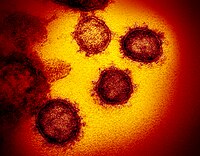
Photo from wikipedia
Severe acute respiratory syndrome coronavirus 2 (SARS-CoV-2) expresses a multifunctional papain-like proteinase (PLpro), which mediates the processing of the viral replicase polyprotein. Inhibition of PLpro has been shown to suppress… Click to show full abstract
Severe acute respiratory syndrome coronavirus 2 (SARS-CoV-2) expresses a multifunctional papain-like proteinase (PLpro), which mediates the processing of the viral replicase polyprotein. Inhibition of PLpro has been shown to suppress the viral replication. This study aimed to explore new anti-PLpro candidates by applying virtual screening based on GRL0617, a known PLpro inhibitor of SARS coronavirus (SARS-CoV). The three-dimensional (3D) structure of SARS-CoV-2 PLpro was built by homology modeling, using SARS-CoV PLpro as the template. The model was refined and studied through molecular dynamic simulation. AutoDock Vina was then used to perform virtual screening where 50 chemicals with at least 65% similarity to GRL0617 were docked with the optimized SARS-CoV-2 PLpro. In this screening, 5-(aminomethyl)-2-methyl-N-[(1R)-1-naphthalen-1-ylethyl]benzamide outperformed GRL0617 in terms of binding affinity (−9.7 kcal/mol). Furthermore, 2-(4-fluorobenzyl)-5-nitro-1H-isoindole-1,3(2H)-dione (previously introduced as an inhibitor of cyclooxygenase-2), 3-nitro-N-[(1r)-1-phenylethyl]-5-(trifluoromethyl)benzamide (inhibitor against Mycobacterium tuberculosis), as well as the recently introduced SARS-CoV-2 PLpro inhibitor 5-acetamido-2-methyl-N-[(1S)-1-naphthalen-1-ylethyl]benzamide showed promising affinity for the viral proteinase. All of the identified compounds demonstrated an acceptable pharmacokinetic profile. In conclusion, our findings represent rediscovery of analgesic, anti-inflammatory, antibacterial, or antiviral drugs as promising pharmaceutical candidates against the ongoing coronavirus.
Journal Title: Journal of Proteome Research
Year Published: 2020
Link to full text (if available)
Share on Social Media: Sign Up to like & get
recommendations!